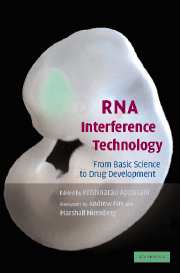Book contents
- Frontmatter
- Contents
- Foreword by Andrew Fire
- Foreword by Marshall Nirenberg
- List of Contributors
- Introduction
- Section one Basic RNAi, siRNA, microRNAs and gene-silencing mechanisms
- Section two Design, synthesis of siRNAs
- 6 Design and synthesis of small interfering RNA (siRNA)
- 7 Automated design and high throughput chemical synthesis of siRNA
- 8 Rational design of siRNAs with the Sfold software
- 9 Enzymatic production of small interfering RNAs
- Section three Vector development and in vivo, in vitro and in ovo delivery methods
- Section four Gene silencing in model organisms
- Section five Drug target validation
- Section six Therapeutic and drug development
- Section seven High-throughput genome-wide RNAi analysis
- Index
- Plate section
- References
9 - Enzymatic production of small interfering RNAs
Published online by Cambridge University Press: 31 July 2009
- Frontmatter
- Contents
- Foreword by Andrew Fire
- Foreword by Marshall Nirenberg
- List of Contributors
- Introduction
- Section one Basic RNAi, siRNA, microRNAs and gene-silencing mechanisms
- Section two Design, synthesis of siRNAs
- 6 Design and synthesis of small interfering RNA (siRNA)
- 7 Automated design and high throughput chemical synthesis of siRNA
- 8 Rational design of siRNAs with the Sfold software
- 9 Enzymatic production of small interfering RNAs
- Section three Vector development and in vivo, in vitro and in ovo delivery methods
- Section four Gene silencing in model organisms
- Section five Drug target validation
- Section six Therapeutic and drug development
- Section seven High-throughput genome-wide RNAi analysis
- Index
- Plate section
- References
Summary
Introduction
RNA interference is a powerful natural phenomenon of post-transcriptional gene silencing that has been found in several biological systems. Small interfering RNAs (siRNAs) are important reagents in the RNA interference pathways that determine gene-specificity of the pathway. RNA interference can be induced in a system by the application of artificial siRNAs. Small interfering RNAs are vital intermediates in natural RNA interference that determine gene specificity of the phenomenon. RNA interference can be engineered for a gene for which this process does not occur in nature by applying artificial siRNAs, to study its function or for therapeutic purpose (Dykxhoorn et al., 2003). The original way of producing siRNAs was by chemical synthesis, which is expensive and usually there is no guarantee that reagents would produce desired gene silencing effects. A number of laboratories have developed alternative methods of producing siRNAs involving plasmid- or virus-mediated intra cellular expression and in vitro with the use of bacterial or viral enzymes. This chapter provides an overview of methods of producing siRNAs by enzymatic means.
Production of siRNAs by in vitro transcription
Donze and Picard (2002) reported a method based on the use of T7 RNA polymerase and short synthetic oligonucleotides as template (Milligan et al., 1987) in producing siRNAs and showed that siRNAs produced with this in vitro transcription method were capable of silencing GFP expression in human HeLa and that of protein kinase PKR in HEK293T cells.
- Type
- Chapter
- Information
- RNA Interference TechnologyFrom Basic Science to Drug Development, pp. 139 - 144Publisher: Cambridge University PressPrint publication year: 2005



